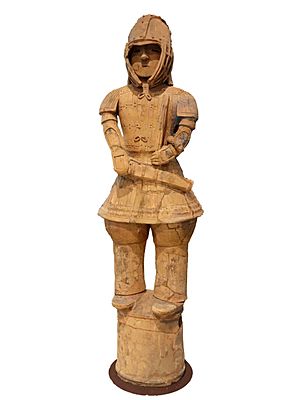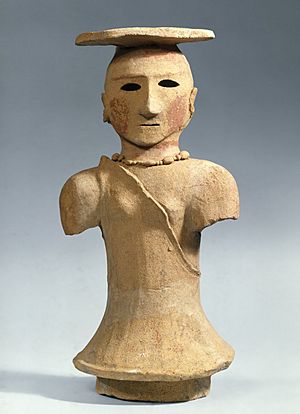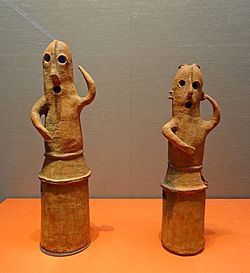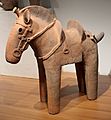Haniwa facts for kids

The Haniwa (埴輪) are terracotta clay figures that were made for ritual use and buried with the dead as funerary objects during the Kofun period (3rd to 6th centuries AD) of the history of Japan. Haniwa were created according to the wazumi technique, in which mounds of coiled clay were built up to shape the figure, layer by layer.
Haniwa were made with water-based clay and dried into a coarse and absorbent material that stood the test of time. Their name means "circle of clay", referring to how they were arranged in a circle above the tomb. The protruding parts of the figures were made separately and then attached, while a few things were carved into them. They were smoothed out by a wooden paddle. Terraces were arranged to place them with a cylindrical base into the ground, where the earth would hold them in place.
During the Kofun period, a highly aristocratic society with militaristic rulers developed. The cavalry wore iron armor, carried swords and other weapons, and used advanced military methods like those of northeast Asia. Many of them are represented in haniwa figurines for funerary purposes.
The most important of the haniwa were found in southern Honshū—especially the Kinai region around Nara—and northern Kyūshū. Haniwa grave offerings were made in many forms, such as horses, chickens, birds, fans, fish, houses, weapons, shields, sunshades, pillows, and humans. Besides decorative and spiritual reasons of protecting the deceased in his afterlife, these figures served as a sort of retaining wall for the burial mound.
Because these haniwa display the contemporary clothing, hairstyle, farming tools, and architecture, these sculptures are important as a historical archive of the Kofun Period.
Everyday pottery items from that period are called Haji pottery.
Significance
Originally, the cylindrical type haniwa were set on top of the funeral mounds, so it is believed that they had a purpose in funeral rituals; however, as the haniwa became more developed, they were set toward the outside of the grave area. It is thought that they were used as boundary markers for the borders of the gravesite.
There is a theory that the soul of the deceased would reside in the haniwa, as the earlier haniwa were placed on top of the funeral mounds. There are haniwa that are equipped with weapons and armor. These are thought to be containers for souls. The armor and weapons would drive away evil spirits and protect the buried ruler from calamity. Because the horse- and animal-shaped haniwa were normally neatly arranged into a line, it is believed that they were part of a sending-off ceremony.
In modern society
Although the religious implications of the haniwa have largely declined in modern society, the sculptures are prized by many for their aesthetic and historical significance. The works of Isamu Noguchi, for example, were heavily influenced by the haniwa. They have been accepted as "Pure Art", according to Time magazine. Beyond simple appreciation as artistic sculptures, modern popular culture has, in some cases, portrayed the haniwa as containing a sentient entity and not just as a simple empty sculpture.
Video games
- Animal Crossing — haniwa are called Gyroids in the English translation, and are furniture only found buried in the ground. A Gyroid named Lloid appears in several games of the series as a helper NPC, collecting donations to go towards town upgrades and construction projects. They have obtained an emblematic status on the series.
- Dragon Quest — Earthenwarriors, a common enemy through the series, is a small humanoid clay figurine riding a warhorse statuette, mostly visually accurate to its real life counterpart.
- Fantasy Life — One of the exploration areas is a cave named "Haniwa Cave". At one of the locations, a haniwa-like hill is accessible, and from a camera angle, the player can see its in a dancing form.
- Final Fantasy Legend II — "Haniwa" is a rare superboss with astonishing HP regeneration and damage capabilities. This boss is optional and can be escaped from.
- Final Fantasy (series) — Cactuar is a species of plant-like anthropomorphic cacti with a haniwa-like face, and arms posed similarly to the aforementioned dancing forms. Cactuars have made guest appearances in other games.
- Kirby (series) — "Cappies" are common enemies found through the series. They appear to be wearing a mushroom hat, hence the name. This hat can be removed via Kirby's inhale ability, causing the Cappy to show its true haniwa figurie. Cappies share the characteristic face visual, and dancing form.
- Super Smash Bros. for Nintendo 3DS and Wii U — Villager, the player's avatar in the Animal Crossing series, makes an appearance as a fighter, with its side special attack being capable of summoning an explosive rocket-like horizontal directional Gyroid.
- Super Smash Bros. Ultimate — Isabelle makes an appearance as a new fighter. Her down special attack is planting a pressure-operated mine. On trigger, similar to the Villager's Gyroid, the Gyroid rises up underneath the enemy fighter and damages them.
- Touhou Kikeijuu ~ Wily Beast and Weakest Creature — Mayumi Joutouguu is the stage 5 boss and stage 6 midboss of Wily Beast and Weakest Creature, assigned as the head of the Haniwa Army Corps. Crafted by the goddess Keiki Haniyasushin, her clothing is representative of the armor used by the Japanese, including the symbolic lamellar armor. In addition, Mayumi elaborates in one of her dialogues that anything Keiki crafts will have a soul inhabiting it, similar to the cultural belief that haniwas were containers of the souls from the deceased to protect them on the afterlife.
Trading cards
- Yu-Gi-Oh! — "Haniwa" is a Monster card type, posed in a dancing form. Characteristically, it has an Earth attribute, and is a Rock type.
Images for kids
-
Haniwa horse statuette, complete with saddle and stirrups, 6th century
See also
 In Spanish: Haniwa para niños
In Spanish: Haniwa para niños






